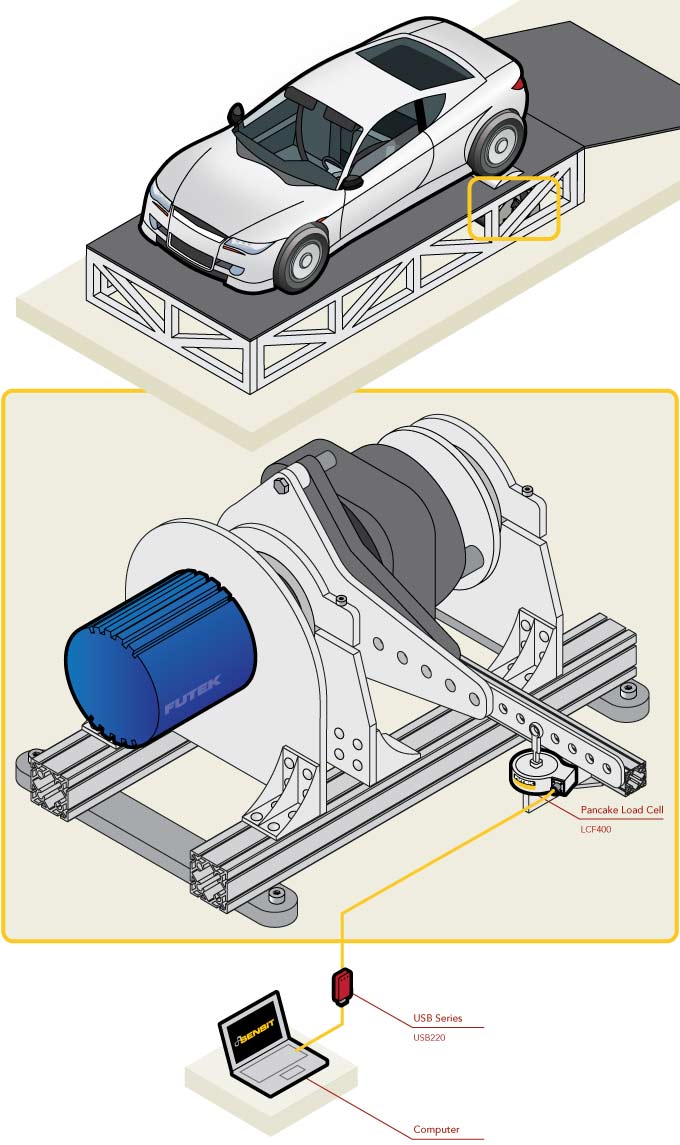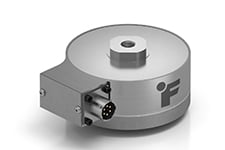How an Engine Dyno Works
Engine manufacturers and performance testing labs use engine dynamometers (or engine dyno) to isolate the engine’s power output and measure performance factors such as horsepower, acceleration, and mileage. Chassis dyno (or car dyno) applies a load against the engine and the torque absorbed by the loading mechanism is then transferred by a torque arm to a load cell sensor, which is integrated into the energy-absorbing device.
However, when an existing engine dyno does not have integrated torque measurement, it can be difficult to retrofit it, as dismantling the existing assembly can be cost-prohibitive or physically not possible. The application presented here provides an alternative solution. This mounting setup features a mechanical loading fixture with a torque arm that indirectly captures the engine torque which is then measured by a load cell.
FUTEK solution
Typically an S-beam Load Cell type is used in both compression or tension mounting configurations. However, FUTEK's proposal is to utilize the LCF Series load cell instead. The benefits of using LCF Load Cell are the following:
- Robust one-piece construction;
- Fatigue and endurance tested;
- Highly Resistant to off-axis loads (extraneous loads).
The LCF load cell accurately measures the load applied by the engine dyno torque arm and provides mV/V electrical signals to the signal conditioner or data-acquisition system. Engineers are then able to analyze the power transfer to the engine and optimize the vehicle performance.
How it Works
The vehicle is secured onto the engine dyno, all support systems are installed and tested and the vehicle is started.
The dynamometer loading mechanism applies a load against the vehicle engine. The load cell reacts to the load applied by the torque arm. As the LCF Load Cell is highly resistant to off-axis loads (extraneous loads), it offsets non linear movements of the torque arm.
As the vehicle engine runs, FUTEK’s LCF Load Cell measures the load that's being applied by the torque arm.
These measurements are sent directly to a paired instrument which provides excitation voltage and signal conditioning (filtering, amplification, digitalization). Depending on the signal conditioner selection, the operator can either view the data on a digital load display or stream the data directly onto a PC or a PLC/DAQ for data logging, control loop safety interlock, or alarming.
Products in Use
LCF400 Load Cell paired with a Digital USB Signal Conditioner.
Contact Us
Please Contact Us with questions.
How an Engine Dyno Works
Engine manufacturers and performance testing labs use engine dynamometers (or engine dyno) to isolate the engine’s power output and measure performance factors such as horsepower, acceleration, and mileage. Chassis dyno (or car dyno) applies a load against the engine and the torque absorbed by the loading mechanism is then transferred by a torque arm to a load cell sensor, which is integrated into the energy-absorbing device.
However, when an existing engine dyno does not have integrated torque measurement, it can be difficult to retrofit it, as dismantling the existing assembly can be cost-prohibitive or physically not possible. The application presented here provides an alternative solution. This mounting setup features a mechanical loading fixture with a torque arm that indirectly captures the engine torque which is then measured by a load cell.
FUTEK solution
Typically an S-beam Load Cell type is used in both compression or tension mounting configurations. However, FUTEK's proposal is to utilize the LCF Series load cell instead. The benefits of using LCF Load Cell are the following:
- Robust one-piece construction;
- Fatigue and endurance tested;
- Highly Resistant to off-axis loads (extraneous loads).
The LCF load cell accurately measures the load applied by the engine dyno torque arm and provides mV/V electrical signals to the signal conditioner or data-acquisition system. Engineers are then able to analyze the power transfer to the engine and optimize the vehicle performance.


